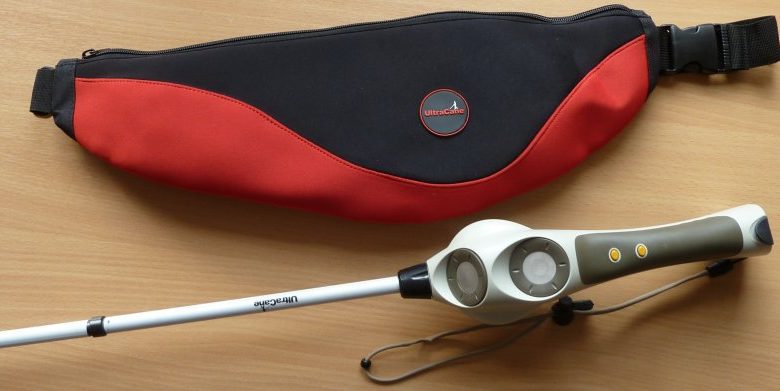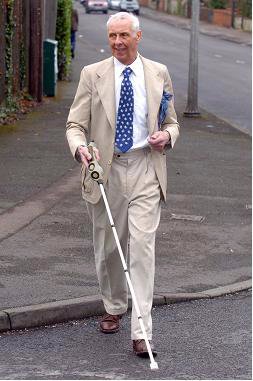
21st century walking sticks
Bill Gulliver MBE, the veteran charity fundraiser with 100 marathons under his belt, was among the first in the country to test drive an advanced electronic mobility aid known as UltraCane. He tells Disability Horizons about the difference that UltraCane makes to his life.
My name is Bill Gulliver, and whilst the running continues to be an important part of my life, at the age of 76, walking is more my style. I am a blind person, living in a sighted world. But I have a window on that world and a much deeper appreciation of it thanks to using an UltraCane.
I use my background as a psychologist to mentor marathon runners and I try to encourage in them an awareness of their environment. For sighted people this is about picking up on the information that they can see, but may not have noticed, such as the colours and shapes of the cars they pass, or the trees on the line of the horizon ahead. The aim is to reduce stress by allowing the mind to focus on the aesthetics and emotions of life as the movements of the physical body become automatic.
An electronic mobility aid developed by the Ultrasound Research Interest Group at the University Of Leeds helps visually impaired people acquire the same information about their surroundings that sighted people can sometimes take for granted. They sought feedback from visually impaired users, including myself, on the prototype and our suggestions were used to improve on the original concept.
They were struck by the lack of technology available to guide the visually impaired. The UltraCane was designed to address issues of safety, confidence and dignity that can sometimes be compromised when walking around in a 21st century environment.
 It works by giving users adequate warning of obstacles ahead of them, both in their path and at head height. The handle of the cane is a handset fitted with transmitters and sensors. Buttons in the handle vibrate when the sensors detect that an obstacle is near. The strength of the vibration indicates the proximity of the obstacle, helping the user to walk around it easily and independently.
It works by giving users adequate warning of obstacles ahead of them, both in their path and at head height. The handle of the cane is a handset fitted with transmitters and sensors. Buttons in the handle vibrate when the sensors detect that an obstacle is near. The strength of the vibration indicates the proximity of the obstacle, helping the user to walk around it easily and independently.
It is easy to underestimate how stressful and restrictive it is for a blind person to have to focus all their thoughts on understanding and avoiding obstacles as they do when using a traditional long cane. If your mind should wander and you start thinking about what to have for dinner or a favourite poem, you risk crashing into a badly parked car, overhanging branches or even end up at the bottom of a newly dug trench, as once happened to me.
I am a writer and a poet and the UltraCane allows my intellectual mind to wander freely without fear of walking into street clutter or other distractions. The developers of the UltraCane considered the protection of the user very carefully and built in both a short and a long distance preview of up to several metres, so users have sufficient time to safely avoid obstacles. I have complete trust in my UltraCane to protect me from catastrophes and injuries and it has never let me down.
With daily practice most users find they can soon walk as smoothly and effortlessly, as sighted people. In fact I would say my UltraCane has introduced me to some wonderful people who want to know how I, as a blind person, seem to be able to avoid obstacles as if by magic! They are intrigued and want to know how it works.
One of the most impressive benefits of using the UltraCane, compared to a traditional long cane, is linked to the way the human brain processes information. The silent vibrations mean the user still has their hearing sense available to detect bird song or traffic hum, whilst the brain is simultaneously interpreting the tactile information.
Apparently, after a little while this type of feedback stimulates a special ‘mind map’ ability in the brain, allowing the user to ‘see’ objects ahead and manoeuvre around them as would a sighted person. I no longer have to focus my attention on the tactile signals. The UltraCane is doing the work for me in the physical world so that I can immerse myself in the abstract world.
Visually impaired people who want to extend the boundaries of life, who wish to get out and about without needing to be guided and taken, can do so because there is a mobility aid that can help them do this.
Knowledge of surroundings frees the blind person to think, and be, in a world of ideas. Knowledge helps you relax and then other people become relaxed around you. Relaxing people and making them laugh: how wonderful for a blind person to be able to do that. Mobility devices like the UltraCane can help the visually impaired get more fun and pleasure from life whilst taking the navigation of new places in their stride.
By Bill Gulliver MBE
To read about more advancements in mobility equipment, visit our Technology section. Let us know about your experiences with mobility aids by emailing us at editor@disabilityhorizons.com, tweeting us at @DHorizons or messaging us on Facebook.
I am consultant for a French design Cie specialized in Seniors developments and products, Good contacts with medical area..Attend to several Seniors European fairs . Could be igterested to built business relationship with you concerning your ULTRA CANE . Waiting for your possible comments and interests . Sincerly yours…Roland G
Interesting, but not by any definition a walking stick, in that it provides support, is it?
Disqus generic email templateapprove
Hi there, the UltraCane is not defined as a “walking stick” it is defined as a “mobility aid” used by people who are blind and partially sited. It replaces the need for a long white cane, which is used to locate obstacles by connecting the tip of the cane with the obstacle itself. The UltraCane detects obstacles before blind and visually impaired people walk into them, thus they have time to walk around them safely!
Is this how a 21st Century walking stills look like now? Well. it looks great. At least they we are lucky that this mobility aid is still continuously living at our time with the touch of innovation as time passes by. This is what handicapped or senior person really need.